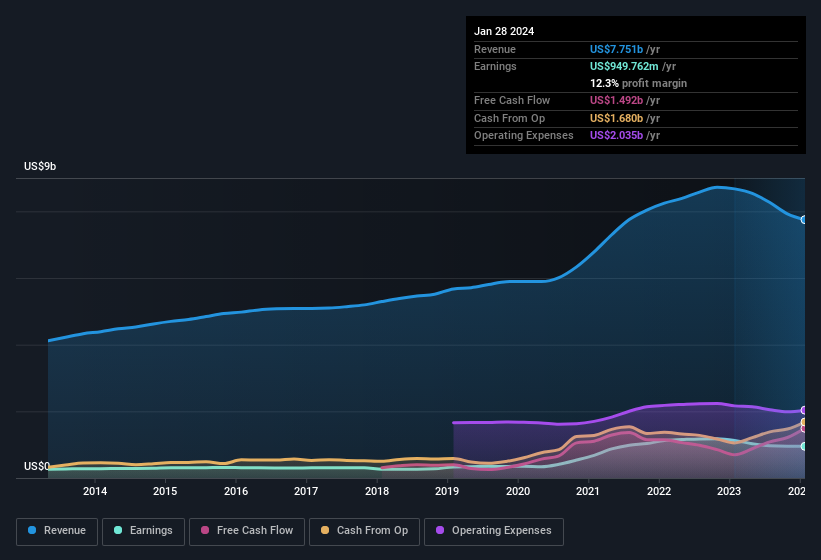- United States
- /
- Specialty Stores
- /
- NYSE:WSM
Williams-Sonoma's (NYSE:WSM) Conservative Accounting Might Explain Soft Earnings

Williams-Sonoma, Inc.'s (NYSE:WSM) recent soft profit numbers didn't appear to worry shareholders, as the stock price showed strength. However, we think the company is showing some signs that things are more promising than they seem.
See our latest analysis for Williams-Sonoma

Examining Cashflow Against Williams-Sonoma's Earnings
As finance nerds would already know, the accrual ratio from cashflow is a key measure for assessing how well a company's free cash flow (FCF) matches its profit. In plain english, this ratio subtracts FCF from net profit, and divides that number by the company's average operating assets over that period. You could think of the accrual ratio from cashflow as the 'non-FCF profit ratio'.
That means a negative accrual ratio is a good thing, because it shows that the company is bringing in more free cash flow than its profit would suggest. That is not intended to imply we should worry about a positive accrual ratio, but it's worth noting where the accrual ratio is rather high. Notably, there is some academic evidence that suggests that a high accrual ratio is a bad sign for near-term profits, generally speaking.
Williams-Sonoma has an accrual ratio of -0.49 for the year to January 2024. Therefore, its statutory earnings were very significantly less than its free cashflow. In fact, it had free cash flow of US$1.5b in the last year, which was a lot more than its statutory profit of US$949.8m. Williams-Sonoma's free cash flow improved over the last year, which is generally good to see.
That might leave you wondering what analysts are forecasting in terms of future profitability. Luckily, you can click here to see an interactive graph depicting future profitability, based on their estimates.
Our Take On Williams-Sonoma's Profit Performance
Happily for shareholders, Williams-Sonoma produced plenty of free cash flow to back up its statutory profit numbers. Based on this observation, we consider it possible that Williams-Sonoma's statutory profit actually understates its earnings potential! And on top of that, its earnings per share have grown at 68% per year over the last three years. At the end of the day, it's essential to consider more than just the factors above, if you want to understand the company properly. Obviously, we love to consider the historical data to inform our opinion of a company. But it can be really valuable to consider what other analysts are forecasting. Luckily, you can check out what analysts are forecasting by clicking here.
Today we've zoomed in on a single data point to better understand the nature of Williams-Sonoma's profit. But there are plenty of other ways to inform your opinion of a company. For example, many people consider a high return on equity as an indication of favorable business economics, while others like to 'follow the money' and search out stocks that insiders are buying. While it might take a little research on your behalf, you may find this free collection of companies boasting high return on equity, or this list of stocks that insiders are buying to be useful.
Valuation is complex, but we're here to simplify it.
Discover if Williams-Sonoma might be undervalued or overvalued with our detailed analysis, featuring fair value estimates, potential risks, dividends, insider trades, and its financial condition.
Access Free AnalysisHave feedback on this article? Concerned about the content? Get in touch with us directly. Alternatively, email editorial-team (at) simplywallst.com.
This article by Simply Wall St is general in nature. We provide commentary based on historical data and analyst forecasts only using an unbiased methodology and our articles are not intended to be financial advice. It does not constitute a recommendation to buy or sell any stock, and does not take account of your objectives, or your financial situation. We aim to bring you long-term focused analysis driven by fundamental data. Note that our analysis may not factor in the latest price-sensitive company announcements or qualitative material. Simply Wall St has no position in any stocks mentioned.
About NYSE:WSM
Williams-Sonoma
Operates as an omni-channel specialty retailer of various products for home.
Flawless balance sheet with solid track record and pays a dividend.
Similar Companies
Market Insights
Community Narratives




